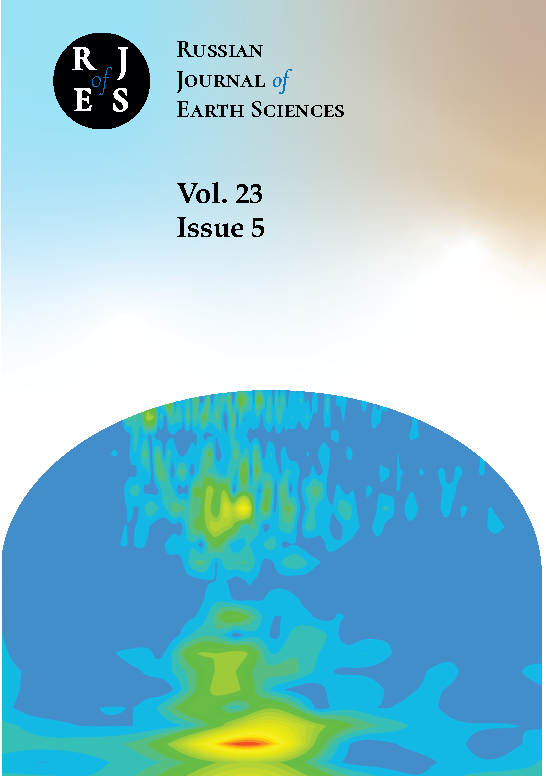Russian Federation
University of Vienna
Russian Federation
UDC 55
CSCSTI 37.00
CSCSTI 38.00
BISAC SCI SCIENCE
Anthropogenic pollution of the atmosphere with organic and inorganic gaseous species has been studied using constant high-quality monitoring of the atmosphere composition both in megacity of Moscow and in its countryside. The article considers continuous measurements of the main climatically and chemically active atmospheric gaseous species concentrations, including volatile organic compounds. The main attention is paid to the comparative analysis, mainly between the megacity and its suburban area, by average species concentrations and some quality features of their seasonal and diurnal variations. The obtained results confirmed the previously studied features of the daily variations of inorganic gaseous species in Moscow and showed such features for organic compounds in the countryside.
minor gaseous species of the atmospheric boundary layer, volatile organic compounds, seasonal and daily variations of concentrations
1. Belikov, I. B., V. A. Belousov, D. P. Gubanova, and A. I. Skorokhod (2019), Variations of concentrations of volatile organic compounds and aerosol particles PM2.5 in the surface layer of the atmosphere of Moscow, in Fundamental and applied aspects of geology, geophysics and geoecology using modern information technologies. V International Scientific and Practical Conference. Part 1, pp. 80-89, IP Kucherenko V. O., Maykop (in Russian).
2. Belousov, V. A., I. B. Belikov, and A. I. Skorokhod (2018), Volatile organic compounds in the surface air according to observations by a proton mass spectrometer, in TURBULENCE, ATMOSPHERE AND CLIMATE DYNAMICS. The International Conference dedicated to the centenary of the birth of Academician Alexander Mikhailovich Obukhov. 16-18 May 2018. Abstracts, p. 116, Fizmatkniga, Moscow (in Russian).
3. Berezina, E., K. Moiseenko, A. Skorokhod, N. V. Pankratova, I. Belikov, V. Belousov, and N. F. Elansky (2020), Impact of VOCs and NOx on Ozone Formation in Moscow, Atmosphere, 11(11), 1262, https://doi.org/10.3390/atmos11111262. EDN: https://elibrary.ru/ICPJMJ
4. Berezina, E., K. Moiseenko, A. Vasileva, N. Pankratova, A. Skorokhod, I. Belikov, and V. Belousov (2022), Emission Ratios and Source Identification of VOCs in Moscow in 2019-2020, Atmosphere, 13(2), 257, https://doi.org/10.3390/atmos13020257. EDN: https://elibrary.ru/EBWQHM
5. de Gouw, J., and C. Warneke (2006), Measurements of volatile organic compounds in the earth’s atmosphere using protontransfer-reaction mass spectrometry, Mass Spectrometry Reviews, 26(2), 223-257, https://doi.org/10.1002/mas.20119.
6. Elansky, N. F., M. A. Lokoshchenko, I. B. Belikov, A. I. Skorokhod, and R. A. Shumskii (2007), Variability of trace gases in the atmospheric surface layer from observations in the city of Moscow, Izvestiya, Atmospheric and Oceanic Physics, 43(2), 219-231, https://doi.org/10.1134/s0001433807020089. EDN: https://elibrary.ru/LKRKZB
7. Elansky, N. F., M. A. Lokoshchenko, A. V. Trifanova, I. B. Belikov, and A. I. Ckorokhod (2015), On Contents of Trace Gases in the Atmospheric Surface Layer over Moscow, Izvestiya, Atmospheric and Oceanic Physics, 51(1), 39-51, https://doi.org/10.7868/s0002351515010034 (in Russian). EDN: https://elibrary.ru/THHWNV
8. Elansky, N. F., N. A. Ponomarev, and Y. M. Verevkin (2018), Air quality and pollutant emissions in the Moscow megacity in 2005-2014, Atmospheric Environment, 175, 54-64, https://doi.org/10.1016/j.atmosenv.2017.11.057. EDN: https://elibrary.ru/XXUAGT
9. Elansky, N. F., A. V. Shilkin, N. A. Ponomarev, P. V. Zakharova, M. D. Kachko, and T. I. Poliakov (2022), Spatiotemporal Variations in the Content of Pollutants in the Moscow Air Basin and Their Emissions, Izvestiya, Atmospheric and Oceanic Physics, 58(1), 80-94, https://doi.org/10.1134/s0001433822010029. EDN: https://elibrary.ru/HQLNSK
10. GAW WMO (2012), WMO/IGAC Impacts of Megacities onAir Pollution and Climate, 304 pp., World Meteorological Organization.
11. Gubanova, D. P., I. B. Belikov, N. F. Elansky, A. I. Skorokhod, and N. E. Chubarova (2018), Variations in PM2.5 Surface Concentration in Moscow according to Observations at MSU Meteorological Observatory, Atmospheric and Oceanic Optics, 31(3), 290-299, https://doi.org/10.1134/s1024856018030065. EDN: https://elibrary.ru/VBDHHO
12. Jordan, C., E. Fitz, T. Hagan, B. Sive, E. Frinak, K. Haase, L. Cottrell, S. Buckley, and R. Talbot (2009), Long-term study of VOCs measured with PTR-MS at a rural site in New Hampshire with urban influences, Atmospheric Chemistry and Physics, 9(14), 4677-4697, https://doi.org/10.5194/acp-9-4677-2009.
13. Taipale, R., T. M. Ruuskanen, J. Rinne, M. K. Kajos, H. Hakola, T. Pohja, and M. Kulmala (2008), Technical Note: Quantitative long-term measurements of VOC concentrations by PTR-MS - measurement, calibration, and volume mixing ratio calculation methods, Atmospheric Chemistry and Physics, 8(22), 6681-6698, https://doi.org/10.5194/acp8-6681-2008.















